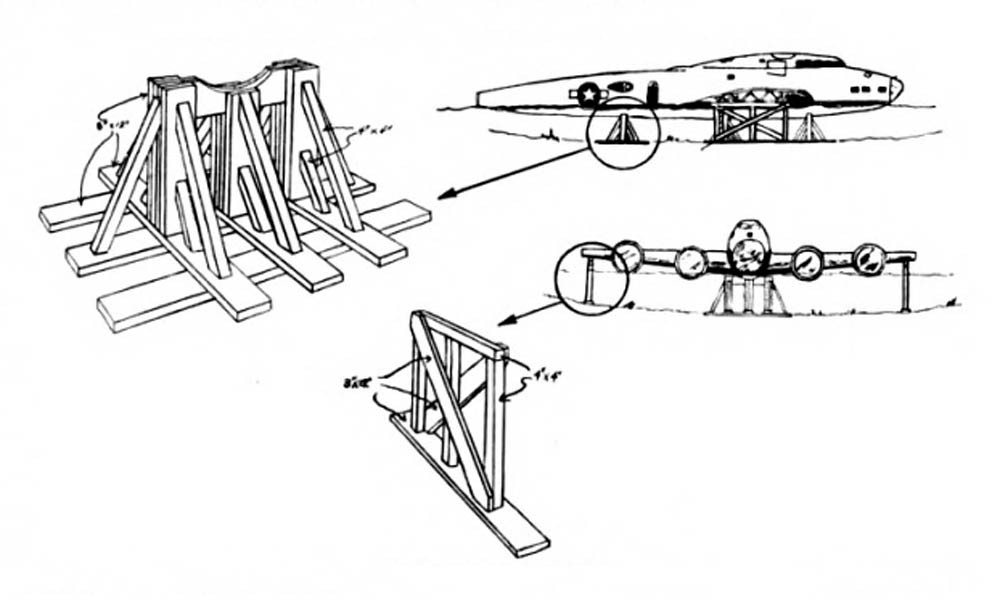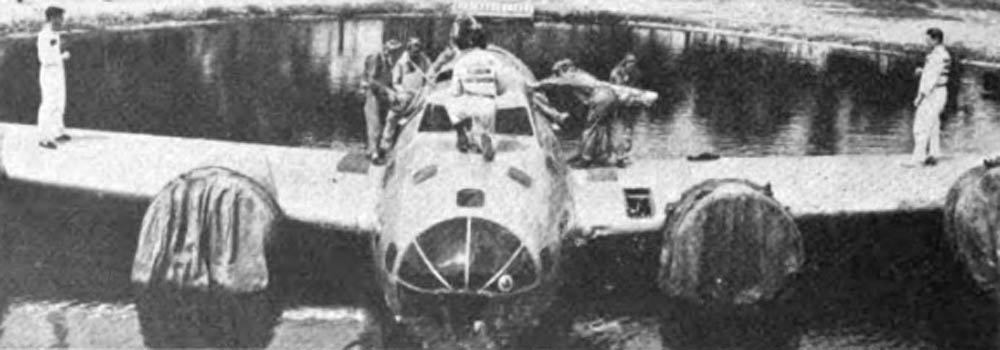Details of a unique B-17 Flying Fortress ditching mockup constructed for training by the 396th Bombardment Group RTU at Drew Field, Florida. (Source: Air Sea Rescue Bulletin, U.S. Coast Guard, January 1945.)
396th Bombardment Group RTU Ditching School Describes
MOCKUP FOR DITCHING DRILL
Publications Give Construction Details and Text for Course
The Ditching School of the 396th Bombardment Group RTU, Drew Field, Fla., Third Air Force, and particularly its B-17 Ditching Mockup, is receiving widespread recognition among Army aviation units having responsibility for ditching training and drill.
The school has been developed in detail both as to its plant and its course. A description of the plant is given in an illustrated book, published at the Field, called “Dinghy-Dinghy, How To Build A Ditching School.” Ditching, itself, and how to drill with a mockup is detailed in a second book, “Dinghy Dinghy. . . Prepare For Ditching,” which, in its introduction, defines ditching as “the art of landing a land-type airplane on water and getting your crew away safely to fly another day.”

CRADLE SUPPORT
Sills Are Located Directly on Sand Bottom of Pool. Water on Airplane Should Hit Approximately at the Trailing Edge of Wing in Order Not to Flood the Radio Compartment Floor.
“All of us will not have to experience a ditching before our flying days are over,” is the way “Dinghy Dinghy” puts it, “but some of us will ditch, of that we can be certain.”
“Two-thirds of our earth is covered with water, and only one-third is covered by land. The chances of having to ditch, in all theaters of operation in this global war, are far too high to be ignored. With these thoughts in mind, let us learn all that can be learned of ditching while our feet are still dry.
“Plenty of air crews, long before your time, have ditched with little or no ill effects. These were the prepared crews.”
The Drew Field mockup is a B-17, but it has been suggested that information developed in building it could be adapted to construction of mockups of other types elsewhere. For this reason cradle are reproduced here, and the illustrations of the fuselage and its 396th Bombardment Group’s “Dinghy-Dinghy, How To Build A Ditching School,” is quoted in part as follows:
“In the center of the (school) area, the pond should be dug to a depth of seven feet. Keep the pond seven deep except on the edges. Over-the-head depth of the water is essential. The pond should be 130 feet long by 100 feet wide at the extremities. The pond may be oval shaped to take advantage of the length. It is advisable to cover the bottom of your pond with sand or lime rock. Concrete would be ideal but the expense would be considerable. If the bottom is not prepared, the crews will stir up the mud and make the water undesirable for drilling.

“A Class 26 Fortress fuselage should be employed for the mockup. Remove the tail assembly and the wing-tips. Mount the fuselage in the length of the pond. The fuselage should be mounted first and the wings attached later. A wooden cradle must be constructed to hold the fuselage at the proper height out of the water. The water should be even with the inboard trailing edge of the wing. When the fuselage has been mounted, attach the wings and support them at the ends with wooden cradles. It is advisable to mount the fuselage in the pond, with the nose resting on the edge of the pond. Any water area left forward of the fuselage will be of no value to the crew but ample maneuver space should be left at the tail. (We did not do this and much valuable space was lost to us.) If the nose is mounted on the edge of the pond you will have space of approximately 60 feet by 50 feet at the tail, which is highly desirable.
“From wing tip to bank of the pond, on each side should be 20 feet. From one bank, construct a wooden ramp out to the wing to afford the crew with access to the fuselage. Build a wooden pier about six inches above water level, at the tail end of the pond. This pier should be approximately 4 feet by 6 feet. Construct a drying rack on the bank, approximately 10 feet by 20 feet, to use for drying of the wet rafts following a drill.

“A 2-inch water inlet is sufficient to afford a change of water. This inlet should be placed at one end of the pond and a 10-inch drain at the other end. (We did not do this in our installation and good circulation is not afforded to our water.) We use the same water that is consumed on our post for drinking purposes. Special permission must be obtained to employ this water for this purpose.
“A condemned hutment was moved into our area to serve as a school and storeroom. It was placed on the bank of the pond, within the fenced area.”
In “Dinghy Dinghy. . . Prepare For Ditching” the information to be imparted to the students has been broken down into five parts, “What Ditching Is All About,” “Every Airman Owes It to Himself To Be Personally Prepared,” “The Actual Facts of Ditching and How to Go About It,” “Life at Sea in a Rubber Raft,” and “Accounts of Actual Ditchings and Excerpts.”









